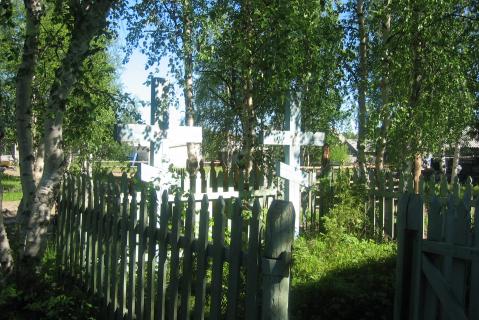Novy Bor special settlement was set up in 1931 by dekulakised peasant families from the Arkhangelsk and Vologda Regions. Subsequently the “Novy Bor” State farm, the largest in the Komi republic, was created here; it was first a sub-division of Ukhtpechlag and then of the Vorkutlag camp system.
The graveyard where the first settlers and their families were buried in 1931-1935 has been lost: today the land is covered by houses. Two graves of forced settlers have survived between Nos 2 and 4 on Lesnaya Street: one bears no name, the other is that of A.A. Vologzhaninova (1864-1935). The owner of No 4, Lesnaya Street looks after the graves.
Repentance: the Komi Republic Martyrology of the Victims of Mass Political Repression (11 vols. 1998-2016), includes entries on 65,000 individuals, from dekulakised peasant families and former citizens of Poland to Soviet German forced labourers, who were deported to the area.
The Memorial online database (2025) lists 129,473 victims in the Komi Republic. (See Nizhny Chov.)
Among them were over 64,000 deportees sent to or born in the Republic. During collectivisation (1929-35) they numbered 20,366, a quarter of whom were aged 1-10. In 1940 there was a massive influx from occupied Polish territory (19,367). More, mainly Germans (5,970) were sent in the 1940s and 1950s (6,699).
The database lists families and individuals (total 1,572) who from 1930 onwards were deported to Novy Bor with their families, and those later born there (118).
It names almost 55,000 who were sent to the camps, where more than 10,000 died. The database lists almost ten thousand prisoners in the Vorkutlag branch of Ukhtpechlag, 1,013 of whom died there between 1935 and 1938. (In 1950 there were 63,000 prisoners in Vorkutlag: see The Gulag in Northwest Russia, 1931-1960.)
| Date | Nature of ceremonies | Organiser or responsible person | Participants | Frequency |
|---|---|---|---|---|
|
nk
|
Commemorative Services
|
nk
|
nk
|
From time to time
|
| State of burials | Area | Boundaries |
|---|---|---|
|
Two headboards have survived
|
not established
|
Fence surrounds two graves
|
[ Original texts & hyperlinks ]
Archive of the Novy Bor State Farm’s “Museum of Labour and Military Glory”
Reply from the Komi Republic Ministry of Culture (No 06-17-1230 of 30 April 2014) to a formal enquiry by RIC Memorial (St Petersburg)

